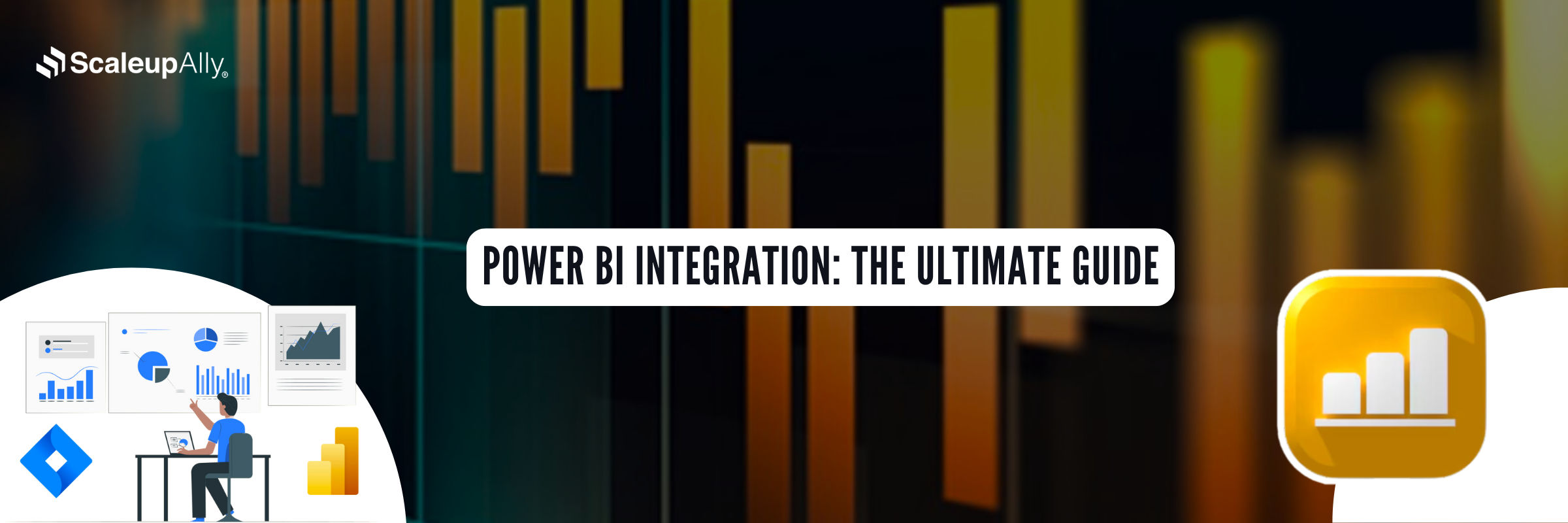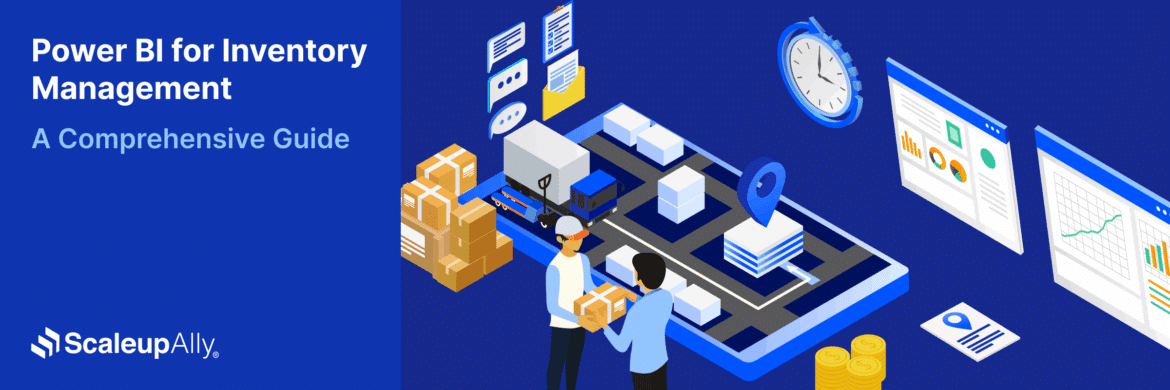
Power BI Integration: The Ultimate Guide
Tarsem Singh | December 21, 2024 , 13 min read
Table Of Content
Data doesn’t scream for attention. It whispers. And often, those whispers get lost by being buried in scattered reports, siloed tools, and systems that don’t quite see eye to eye. To transform these subtle signals into clear, actionable insights that drive meaningful outcomes, Power BI data integration is the go-to.
Power BI integration when done right, bridges the gap between what you know and what you need to see. But the catch is that integration isn’t a one-size-fits-all. It’s a puzzle that is unique to every organization, with no shortcuts.
In this blog, we are not here to tell you what you already know (that Power BI is great or that integrating it is important).
You’ve probably heard that a hundred times. Instead, we’ll tell you about the best practices of integrating Power BI seamlessly, the challenges and solutions of integrating Power BI, and the opportunities most people miss when they settle for “good enough.”
If you’re ready to do more than just connect tools, let’s explore how integration can make your data impossible to ignore.
Key Takeaways
- Power BI integration bridges data silos, creating a unified, real-time view of your business operations for better decision-making.
- Personalized integration strategies are essential to align Power BI with unique workflows and existing systems.
- Challenges like data inconsistencies, performance bottlenecks, and user adoption can be overcome with the right tools.
- Optimizing for scalability and security ensures that Power BI integration not only solves today’s problems but also adapts to future growth.
- Empowering teams through training and intuitive design maximizes the value of Power BI, turning insights into actionable strategies.
Why Integrating Power BI is Necessary for Businesses?
- Why Integrating Power BI is Necessary for Businesses?
- Top Data Sources With Which Power BI Can be Integrated
- 4 Key Features of Power BI Data Integration
- 5 Best Practices for a Seamless Power BI Integration Process
- Power BI Integration Challenges & Solutions
- How can ScaleupAlly Help?
- Conclusion
- Frequently Asked Questions
Data on its own is like a book in a language you don’t understand. It might hold the secrets to your business’s next big move, but without an interpreter, it’s gibberish. Integrating Power BI interprets the data into something useful for your business.
When you integrate Power BI into your existing systems—ideally through expert integration services and solutions—you are syncing every piece of your operation, from sales to logistics, so that you do not make decisions in a vacuum.
Take a minute and reflect on how often data lives in silos. Your CRM knows one thing, your ERP another, and your analytics team has a spreadsheet that’s probably already outdated. When Power BI is integrated, it stitches these pieces together and transforms fragmented insights into a cohesive narrative you can act on.
If you are aiming to be more agile, precise and competitive in your business, Power BI is the nerve centre of decision-making. Integration makes it possible to predict trends, spot opportunities, and fix inefficiencies in real-time.
Top Data Sources With Which Power BI Can be Integrated
Here’s a look at some of the most impactful data sources Power BI can integrate with to transform isolated datasets into actionable insights:
1. Microsoft Excel
Excel remains a go-to tool for businesses globally and Power BI can enhance its capabilities even further. When you integrate Power BI with Excel, you will be able to automatically import spreadsheets, pivot tables, and create custom formulas into dynamic dashboards. There will be no need to update reports manually instead you have live, interactive data at your fingertips.
2. SQL Server
For businesses running on SQL Server, integration with Power BI will be a game-changer for you by enabling you to access structured data and help you visualize trends, forecast outcomes, and analyze performance metrics without writing a single query.
3. Salesforce
Presently, your CRM is bursting with valuable customer data and Power BI can ensure that you make the most of it. When you integrate Power BI with Salesforce, you can track sales pipelines, customer interactions, and team performance to create dashboards that connect every step of your customer journey.
4. Google Analytics
Power BI can turn web traffic data from Google Analytics into an asset by monitoring the site performance, user behaviour, and campaign ROI in one place. It’s the perfect bridge between marketing and business intelligence.
5. SharePoint
If your team relies on SharePoint for collaboration, Power BI integration can simplify the way you analyze documents, project progress, and workflows. It turns collaborative data into digestible visuals that enhance productivity and decision-making.
6. Azure Data Services
For businesses leveraging Microsoft Azure, Power BI creates a seamless link to your cloud-based storage and analytics tools be it Azure Synapse, Azure Blob Storage, or other services. The integration allows for real-time, scalable insights.
7. Dynamics 365
Dynamics 365 powers customer relationships and operations which Power BI complements beautifully. By combining the two, you gain a unified view of sales, customer service, and inventory which is perfect for driving efficiency.
8. Social Media Platforms
From Twitter to Facebook, Power BI can integrate with social platforms to analyze trends, track engagement, and monitor brand sentiment. It will ensure you never miss what your audience is saying.
9. Oracle Databases
For companies relying on Oracle’s database systems, Power BI opens doors to advanced analytics. Integrate effortlessly to visualize enterprise-scale data to optimize performance and strategy.
10. APIs and Custom Connectors
Power BI’s ability to connect with APIs or custom-built connectors means you’re never limited to using niche tools or proprietary systems. You can bring all your data into one cohesive environment for unparalleled analysis when Power BI is integrated.
4 Key Features of Power BI Data Integration
Power BI transforms how businesses interact with data and here are four standout features that make Power BI’s data integration capabilities a game-changer:
1. Connectivity
Power BI offers a library of connectors for integration with data sources (Excel and SQL databases) and cloud platforms (Azure and Google Analytics). If your data lives on-premises, in the cloud, or across multiple platforms, Power BI can pull it together.
2. Real-Time Data Synchronization
The fact of the matter is that stale data leads to stale decisions so Integrating with Power BI will allow for real-time updates from connected data sources. This means that dashboards and reports will always reflect the most current information to give your business the agility to act immediately.
3. Data Transformation with Power Query
Raw data isn’t always analysis-ready and to solve this, Power BI includes Power Query, a built-in ETL (Extract, Transform, Load) tool that helps you clean, shape, and merge data before it’s visualized to ensure your insights are accurate, consistent, and actionable.
4. Unified Data Modeling
Power BI’s data modeling feature allows you to combine datasets, define relationships, and create a unified model for cross-functional analysis to help you see how different parts of your business interact.
5 Best Practices for a Seamless Power BI Integration Process
Integrating Power BI effectively requires more than just plugging in data sources. To truly unlock its potential, you need a thoughtful approach. Here are five best practices to ensure a smooth Power BI integration process:
1. Understand Your Data
Before the integration is done, map out where your data lives and how it’s structured by identifying key data sources wherever they are (in the cloud, on-premises, or scattered across multiple tools). Understanding your data ecosystem ensures that you connect the right dots and avoid redundancies.
2. Keep Data Clean and Consistent
“Garbage in, garbage out” is the rule with data integration, and for clean standardized data, use Power BI’s Power Query to clean your data to remove duplicates, fix inconsistencies, and ensure that formatting is aligned across all sources to avoid misleading insights.
3. Optimize for Real-Time Updates
If your business relies on real-time decision-making, set up automatic refresh schedules for your data connections. Ensure that your key systems, like SQL databases or cloud storage, support frequent updates so your dashboards always reflect current information.
4. Build a Scalable Data Model
As your business grows, so will your data and so, create a flexible data model in Power BI that can handle future scaling. Use relationships, hierarchies, and measures wisely to maintain performance and make your reports adaptable to new data sources.
5. Prioritize Security and Compliance
With sensitive data at your business in play, security can’t be an afterthought. You must leverage Power BI’s security features early, like row-level security (RLS), to control who sees what. Also, ensure compliance with industry standards and regulations if you’re handling personal or financial data.
Also Read: 36 Valuable Power BI Best Practices You Should Know
Power BI Integration Challenges & Solutions
Integrating Power BI into your data ecosystem can unlock incredible value, but it’s not without hurdles. Here’s a look at some common challenges you might face and practical ways to overcome them:
1. Challenge: Data Silos and Inconsistent Sources
Many organizations struggle with fragmented data stored in isolated systems which leads to gaps or mismatched formats during integration.
Solution: Begin with a data inventory. Identify all sources and use Power Query to clean and unify your data before integration. Leverage tools like data warehouses or Azure Data Factory to centralize disparate datasets for smoother connectivity.
2. Challenge: Real-Time Data Sync Issues
Keeping dashboards up-to-date in real time can be a challenge when dealing with legacy systems or high data volumes.
Solution: Configure automatic data refreshes in Power BI and ensure your source systems support frequent updates. For large datasets, implement incremental refresh to process only changes to save time and resources.
3. Challenge: Performance Bottlenecks
As data complexity grows, dashboards can become sluggish, impacting user experience and decision-making.
Solution: Optimize your data model by removing unnecessary columns, using aggregations, and minimizing calculated fields in reports. Consider using DirectQuery for large datasets to query the source directly instead of importing it.
4. Challenge: Limited User Adoption
Even the best-integrated systems fail when users don’t engage with them, often due to a lack of training or overwhelming interfaces.
Solution: Provide targeted training sessions and create role-specific dashboards that present only relevant insights. Make the interface intuitive and share success stories to demonstrate the value of Power BI.
5. Challenge: Security Concerns
Sensitive data can be exposed if proper security measures aren’t implemented during integration.
Solution: Use Power BI’s row-level security (RLS) to restrict access to data based on roles. Configure encryption for data at rest and in transit, and regularly audit user permissions to ensure compliance with organizational policies.
Also Read: Power BI Implementation: A Step-by-Step Guide for Businesses
How can ScaleupAlly Help?
Integrating Power BI is more than combining two pieces of software together—it’s about creating a seamless data flow that transforms operations. ScaleupAlly offers end-to-end Power BI services including and not limited to: crafting tailored integration strategies to address your unique challenges and goals. From syncing legacy systems to building real-time dashboards, we ensure Power BI enhances your workflow without disruption.
Our support extends to training and optimized dashboards, empowering teams to confidently embrace data-driven decisions. Plus, we future-proof your systems to evolve with your business. With ScaleupAlly, Power BI integration drives smarter, faster, and more impactful decisions. Connect with us to get started!
Conclusion
Power BI integration redefines how businesses understand and act on their data by showing the difference between reacting to problems and predicting them. When done right, it can transform the way decisions are made by empowering teams to think bigger, move faster, and achieve more.
But integration is only as good as the strategy behind it. It requires intention, expertise, and a willingness to break away from the status quo. The question isn’t whether Power BI can fit into your business but whether your business is ready to unleash its full potential.
So, are you ready to stop looking at data as numbers and start seeing it as your competitive edge? The tools are there, the opportunities are endless, and the first move is yours to make.
Frequently Asked Questions
Q: What can I integrate Power BI with?
Power BI integrates with a wide range of sources, including Excel, SQL databases, cloud platforms like Azure, CRMs like Salesforce, and even social media platforms to facilitate comprehensive data analysis.
Q: Is Power BI an integration tool?
No, Power BI isn’t primarily an integration tool. It’s a data visualization and analytics platform. However, it connects seamlessly with various systems and consolidates data, making integration a critical aspect of its functionality.
Q: What is Power BI compatible with?
Power BI is compatible with numerous data sources such as cloud platforms (Azure, Google Analytics), on-premises databases (SQL Server, Oracle), and productivity tools like SharePoint and Microsoft Teams.
Related Blogs

Data Warehouse Cost Breakdown: Factors, Pricing Models & Platform Comparison
Discover how much a data warehouse costs in 2025. Explore pricing models, key factors, and platform comparisons to plan your data budget effectively.
Tarsem Singh
Nov 6 ,
14 min read

How Much Do Integrations Cost? [Pricing Breakdown & Key Insights]
Learn how much integrations cost, key factors influencing pricing, hidden expenses to avoid, and effective ways to reduce integration costs.
Tarsem Singh
Nov 6 ,
9 min read

Power BI for Inventory Management: A Comprehensive Guide
Explore the hidden power of Power BI for inventory management and how it provides businesses with powerful analytics and visualization capabilities.
Tarsem Singh
Oct 8 ,
19 min read



